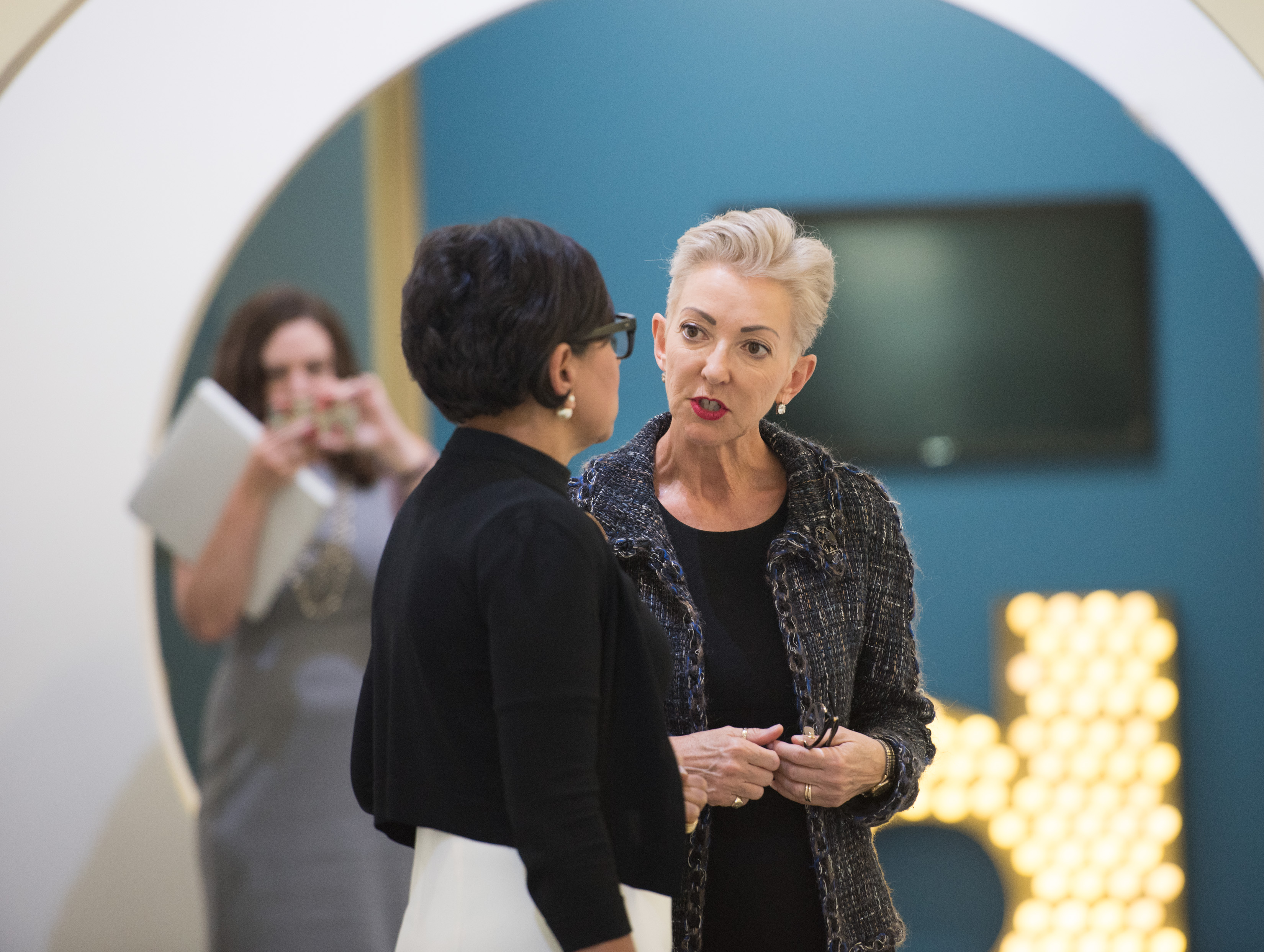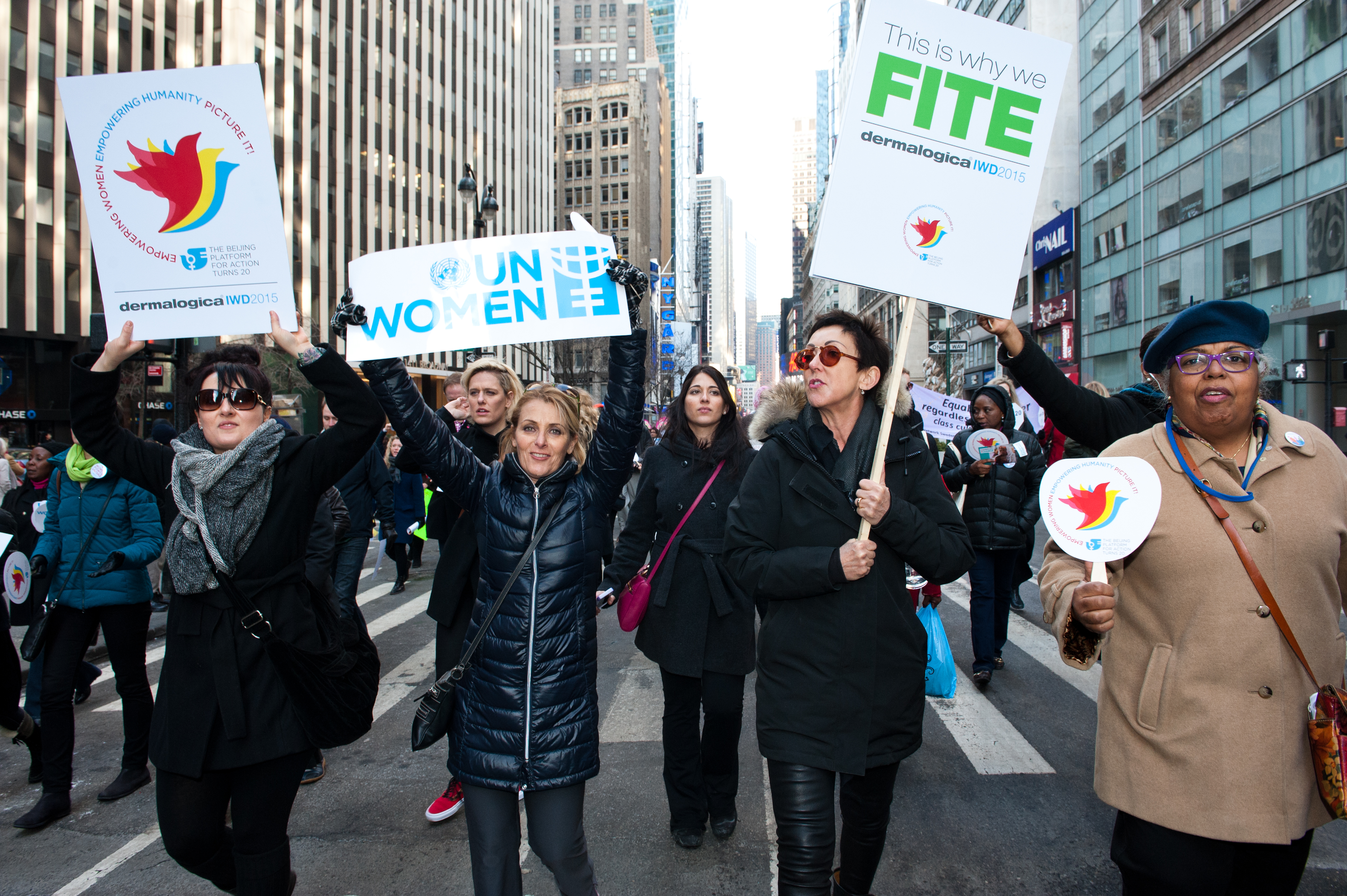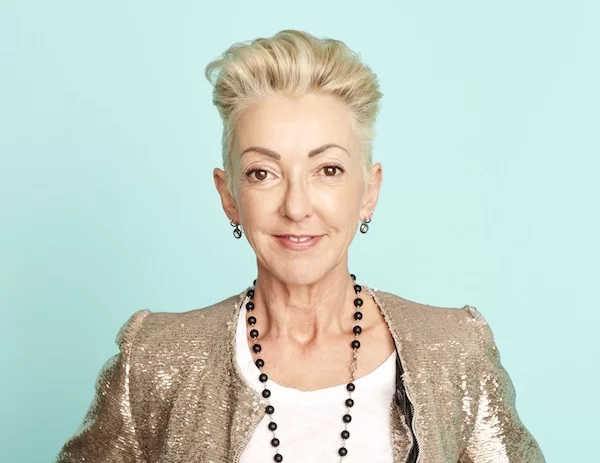After working at salons during her teen years, Jane Wurwand leveraged a professional apprenticeship into a successful career as a skin therapist in her native UK. Upon immigrating to the US in 1983, she was surprised to learn that skin and body therapy education was practically nonexistent on this side of the pond, so she opened her own classroom under the name International Dermal Institute (IDI). Shortly after, she self-financed her own skincare line, Dermalogica.
Fast-forward over three decades later, and IDI educates more than 75,000 skin therapists annually at 38 training centers worldwide. Wurwand bootstrapped Dermalogica all the way to an acquisition by Unilever in 2015, and the line is now sold in over 80 countries.
All the while, she kept a keen focus on educating and empowering salon professionals, which she says creates a talent pipeline for female entrepreneurs: the salon industry produces more women entrepreneurs than any other sector, and 64 percent of salons are owned by women. In 2011, she pushed Dermalogica’s commitment a step further with the Financial Independence Through Entrepreneurship initiative to help women and girls access education, vocational training, loans, and leadership opportunities. To date, the program has helped fund more than 91,000 loans and given educational scholarships to women and girls in 15 countries.
Her journey from apprentice to millionaire entrepreneur and philanthropist may sound exceptional, but Wurwand is out to create more success stories like hers by raising awareness of vocational training.
“My mother was widowed at age 38. She hadn’t worked since she got married, but thankfully she was a qualified nurse and was able to fall back on her training. She told my sisters and me, ‘Learn how to do something.’ Those were the five most important words I heard in my life,” Wurwand tells Conscious Company. “Now that I am at this point in my career, I see my role as making sure that women like my mum have those opportunities.”
While an apprenticeship-to-work track gave Wurwand her start, she says access to similar programs is sorely lacking in the US, and she’s out to educate small business owners and big-time CEOs about the win–win benefits of giving young people a leg up. We spoke with Wurwand about her vision and how vocational training can empower tomorrow’s entrepreneurs — and maybe save our economy in the process.
After more than 30 years as an entrepreneur, what’s next for you?
Jane Wurwand: I’m all about job creation right now, and one of the most overlooked areas for job creation is entrepreneurship. The UN says we need to create 600 million new jobs over the next decade to accommodate incoming and displaced workers. Most of those jobs won’t come from big companies. They’ll come from small entrepreneurs, who are the long tail of job creation. Those same entrepreneurs — people who hire themselves and a handful of others — can also rebuild our Main Streets, our High Streets, and our communities. The fastest way to become an entrepreneur is through skill-set training and vocational training — what I like to call job-driven education —and one of the key pieces is an apprenticeship program.
Less than 1 percent of Americans are involved in any kind of apprenticeship program, so many people don’t even know what it is. They think it’s the same as an internship, but it’s not. It’s a fully-fledged, contracted, indentured apprenticeship that results in a learned skill-set. We have lost sight of the benefits this model can offer, especially in the United States — where millions of jobs cannot be filled because we don’t have enough skilled workers. Everyone is pursuing the university route, which is a fantastic educational opportunity, but it’s not for everyone and certainly not the fastest way to become an entrepreneur while taking on minimal debt.
My goal is to raise the awareness of what I call the “missing middle.” We know about the four-year high-school qualification, and we talk a lot about the four-year college degree. But there’s a middle path, which is typically the two-year apprenticeship or skill-set education through community colleges, trade and technical colleges, and on-the-job training. This segment is so underserved and could be an enormous opportunity for so many people in this country. I’m looking to push that angle hard and get in front of enough CEOs and founders to say, “Why don’t we emulate some of the programs in the UK — for example, the City and Guilds programs — to carve out new opportunities for job creation in the US?”
What kind of response do you get when you talk about this idea?
JW: It’s very different in the UK. There, I was actually honored by City and Guilds, which is a thousand-year-old government and training body, so this is well-established in the UK. When I talk about apprenticeships, guilds, and trade training in the States, the response is most often, “What is that?” People just don’t know.
We don’t have to reinvent the wheel. Although they are little known, the best practices are there. Former President Barack Obama instituted a government-backed apprenticeship program, Apprenticeship USA, toward the end of his presidency. It wasn’t exactly picked up by the current administration, but even the current administration has talked about apprenticeships. The point is: How are we introducing these programs, how are we getting the word out, and how impactful can it be?
Why does this feel like the mission that’s worth your time?
JW: I’ve been in the professional salon industry my whole life. I got my first job at 13 working on Saturdays at a local hair salon, and then I went on to do my apprenticeship and get my skill-set training. That’s the base of my career. It fueled my life’s journey, and I spent that time surrounded by women — 98 percent of skin therapists are women — who had the same journey. I’ve seen job-driven education create such major opportunities, yet nobody talks about it and nobody recognizes it.
For many years I battled against this spoken or unspoken attitude of: “You went to beauty school? Really?”
For many years I battled against this spoken or unspoken attitude of: “You went to beauty school? Really?” People think it’s something you do if you’re not smart enough to do anything else. It’s a stereotype we laugh about in our industry, because people don’t realize that the salon industry creates more entrepreneurs — specifically women entrepreneurs — than any other sector.
Having spent 40 years in this industry, I believe we’re a blueprint of how to do it, and having the opportunity to be successful in the industry gave me a platform to identify my purpose. I feel compelled to talk about job-driven education because I’ve lived it, I’ve seen it, and I’ve been surrounded by it, yet I hear so little about it here in the States. We have to support our entrepreneurs if want to maintain our job creation and economy.
Some may fear that the jobs you’re talking about aren’t necessarily what you’d call “good jobs.” The New York Times ran a series in 2015 exposing labor abuses in the city’s nail salons, for example, which shocked a lot of people. Obviously, that’s not what you’re advocating. But beyond creating more small businesses, what role can these small businesses play in creating thriving communities and fair working environments?
JW: In any industry, you will have good jobs and not so good jobs. I’m advocating for people to not only work in a salon, where average salaries range between $30,000 and $46,000 a year, but also work toward owning their own salon. That opportunity exists, and it can impact the community far beyond the business owner. A startup salon typically employs three to five people. That may not sound like a lot, but we call those people “jewel boxes,” because employing them positively impacts their families and ripples out into the community.
It’s also important to remember that businesses like salons are about more than the services offered. A salon is a community hub. It’s a place where people debrief, tell their stories, and know each other. It’s like a neighborhood gathering place, especially for women. In Kabul, Afghanistan, for example, salons were some of the first businesses to open after the fall of the Taliban, as documented in the 2004 film “The Beauty Academy of Kabul.” That’s not because people suddenly decided they needed to get their nails done. Those salons became places where people — specifically women —could go to share their stories, talk about what happened, and reconnect.
You see similar stories play out in the United States. After moving our daughter into the University of Maryland for her freshman year, my husband and I drove through the Shenandoah Valley and stopped for the night in a small town called Luray, Virginia. It had obviously been very successful in the last century with mining and textiles, but those industries had since gone and the High Street was decimated. Only a few charity shops and restaurants remained, but five salons were still open and each had a few patrons inside. That was the last piece of what was left on that High Street, and there’s no way anyone is ever going to receive a service like that online or by artificial intelligence, at least not yet. And even if it becomes available, I’m not sure we would want it.

Dermalogica Founder Jane Wurwand and US Secretary of Commerce Penny Pritzker Tour Dermalogica headquarters in Carson, California,
Photo by Jennifer Graylock-Graylock.com
When you say people come to businesses like salons for more than the services — and that they wouldn’t want these services if they were automated — can you elaborate a bit more on what you mean?
JW: These are jobs that are humans being more human. These are jobs where people are literally touching each other.
One of my first clients was a woman in her 80s, and she came to me because I was an apprentice and our charges were much cheaper. She took two buses to get to me every two weeks, and when she paid for her skin treatments, she counted out the money very carefully. I thought, “I don’t think she has a lot of money, and she’s coming every two weeks.” I felt kind of guilty that she might think that was necessary, so I thought I was doing her a favor when I told her she would see similar results even if she came less frequently. She hesitated for a moment, and then she grabbed hold of my hands and said, “You know dear, if you don’t mind, I’d like to still come as often as I do because this is the only place anyone touches me.”
I was 19 at the time, so I wasn’t quite sure what to make of it. But after living in the career as long as I have, I now know that there are all kinds of reasons why people come to a small business. People don’t visit the corner store every day because they’re always running out of groceries. They do it because they want to see people. When people sit in coffee shops with their laptops for hours, it’s not because they don’t have electricity or Wi-Fi at home. It’s because they want to be around people.
People don’t visit the corner store every day because they’re always running out of groceries. They do it because they want to see people.
We lose sight of what our small businesses do for us — our High Street dog groomer, the neighborhood car mechanic, the local bookshop with poetry readings and a children’s corner, the small diner or coffee shop where people gather, the salon, the florist. All of these small businesses employ people in what may not initially seem like “good jobs,” but those are the businesses and those are the people that make us feel we belong in our communities.
How do small businesses make a community better?
JW: It’s not just about how big they are but how big their impact is, and I think their impact is enormous. It’s why everybody wants to live in the neighborhood with the new family-owned shop or artisanal bakery. People think: “I want to live near those places and the people who will go into them. I’ll get to know people, and I’ll feel connected.” This idea of human connection is an even bigger footprint for small businesses than the financial impact they may have, although the financial impact is huge for the people who work there.
Yes, we need our big businesses. We need our tech. We all love shopping on Amazon. But when people talk about how sad they are that a local bookstore closed, my answer is: “Did you buy books there? Because if you don’t, it can’t stay open.” In West Los Angeles, where I live, I see stores going out of business on a weekly basis. Some have been around for 30 years or more, but brick-and-mortar businesses are finding it hard to survive in the Internet age. We have to figure out what brick-and-mortar stores offer that can’t be replicated online. It has to be quite literally a human connection: Humans being more human.
Your industry is made up of mostly women-run businesses, and you work in a foundation with a focus on women entrepreneurs. Do you feel women are key to this broader conversation about promoting entrepreneurship?
JW: Yes, and it’s not just a gender issue. Studies continue to show that, globally, women invest more of their income into their families and local communities compared to men. That’s not to say, “Look how bad men are.” That’s not the point at all, because men may put more into traditional investments, but surely we should put equal dollars into the hands of whichever group is putting the most directly back into their family and their community.
But the reality is that we don’t. Women earn less. We own less than 1 percent of the titled land on the planet. We are often in situations where we earn money, but we aren’t able to keep it or access it. Women aren’t even issued birth certificates in some countries, so they can’t get a SIM card for a cell phone, for example, because they don’t have identification. In other countries, women have to go through a male family member to open a bank account, and they can only access it with the help or permission of that male relative. There are all kinds of stories in both the developed and developing worlds in which women are significantly disadvantaged by their circumstances. If they were able to earn their own money, access it, and keep it, we know from the studies that it would have a direct impact on their families and the families in their communities, which can have an impact on entire countries.
If another demographic group was struggling to make, access, and keep their money —despite data showing that they are more likely to invest it in a way that directly impacts their communities — I would feel the same way about the need to empower them. But it happens to be women, and because it’s something I know well and feel strongly about, I’m compelled to speak up specifically for, and about, women.

Wurwand (holding FITE sign) marches in support of female entrepreneurs.
What is your call-to-action for business leaders? How can they support tomorrow’s entrepreneurs?
JW: I want everyone who owns a business — no matter how small — to ask themselves: “Does apprenticeship exist in my industry? Could I bring in a young person, pay them, and help them learn a valuable skill?” Existing apprenticeship programs are often under-utilized, so understanding what’s out there and how your business can participate is the first step.
For large companies in particular, leaders need to think more seriously about apprenticeships — not just internships. The blueprints are there through programs such as City and Guilds in the UK, and the people who operate these programs are eager to help anybody establish apprenticeships in their businesses.
As a society, we all need to do a better job of supporting small entrepreneurs. Don’t think everything has to be done in a big-box store or online. Find the small entrepreneurs in your community and support them. We have Small Business Saturday, but really we should support small entrepreneurs every day. If you’re involved in your communities or in your city councils, be vocal about it. We have to support our local businesses.
What do people most often get wrong about apprenticeships and job-driven education, particularly in the United States?
JW: Studies show that most UK students decide if they will be university-bound by the time they’re 12 years old, so conversations about life and career need to start early. Here’s the question: Why aren’t we exposing American middle-schoolers to viable alternatives to the four-year college program? What paths are we offering to our youth, specifically minority youth? Why aren’t we telling them about this missing middle?
The message today is often: You’re either going to graduate with a high-school diploma, or if you’re smart enough or wealthy enough, you’re going to go to university. The costs of trying to pursue a path that may not be right for you can really add up. It costs $135 to take the SAT once, and most students take it a couple of times with practice tests and tutoring. Students are told to apply to a dozen colleges, but application fees can be up to $100 each. There’s an elitism that nobody really likes to talk about. It’s a barrier for a lot of kids, and if we don’t offer a viable career alternative, then what?
What can we do to better prepare young people for the workforce?
JW: We are underserving our young people by not exposing them to different opportunities and allowing them to take different paths. Undergraduate and graduate degrees are terrific qualifications, but college is not for everyone. We need to make sure young people know about the alternatives.
Bring local business owners into middle and high schools to talk about how they got started and how students can do it, too. While we’re at it, why not offer a parallel path? With the right direction, students can complete skill-set education alongside their standard classwork in the final years of high school. When they graduate, they will not only have a high-school diploma, but also a qualification that can immediately put them to work—whether it’s in cosmetology, electrical, or another in-demand field.
And it’s not a question of either/or: Learning a marketable skill in high school can also help students pay their way through college, if they plan to go. There are a lot of creative ways we can look at future job creation if we make these opportunities known and available to young people.
For final words of advice: What makes a great leader?
JW: A key quality for leaders is empathy — whether you’re leading a business, leading a family, or even leading a country. To manage and to lead are two very different things. Good managers may have a knack for organizing and coordinating things, but leadership is a little different. Hopefully all leaders are good managers, but more importantly, leadership is about inspiring and motivating others to do their very best. In order to do that, you have to understand them. It sounds so simplistic, but it’s almost impossible to understand another person’s views, strengths, and weaknesses if you do not have empathy.
What I’ve learned over the years at Dermalogica is something I call chess leadership: It’s all about having the right piece in the right square at the right time. Every single piece moves differently, and they must, in order for you to win the game. I look at business this way. You have to know your pieces and know how to put them in their best position on the board so they can be the greatest they can be. Accomplishing this is the hallmark of leadership, and the root of such a success is extreme empathy.
I work at this all the time. I work really hard to remember where I come from — my family, my industry, my journey, and my story — which keeps me thinking constructively about how I can be the most useful. When you’ve reached a level of success in your career and a level of longevity in your life, you start thinking about the next step. And it has to be the legacy you will leave for others, because at the end of the day, the death rate is holding steady at 100 percent.





